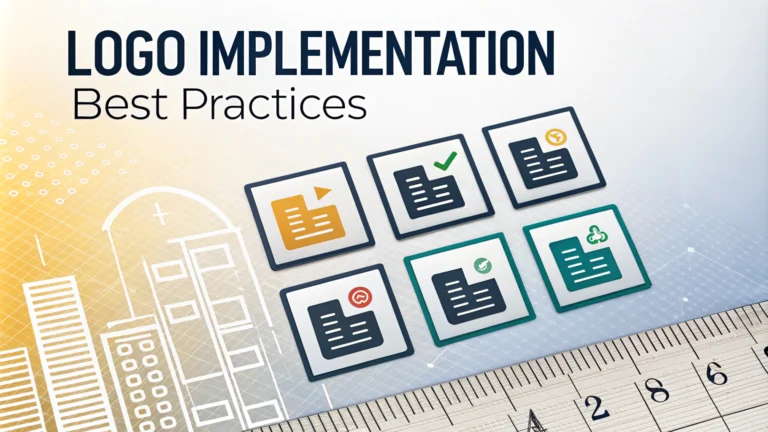A well-implemented logo strengthens brand recognition and creates lasting impressions across all touchpoints.
Size and Scaling Guidelines
- Create logos in vector format using Adobe Illustrator or similar software
- Test logos at multiple sizes (favicon to billboard)
- Maintain clear space around logo equal to the height of a logo element
- Design separate versions for very small applications (like app icons)
Color Applications
- Develop both full-color and single-color versions
- Include reversed (white) option for dark backgrounds
- Specify exact color values (Pantone, CMYK, RGB, HEX)
- Test against light, dark, and colored backgrounds
File Format Requirements
| Format | Use Case |
|---|---|
| .ai or .eps | Master files for editing |
| .svg | Web and digital displays |
| .png | Digital applications with transparency |
| .jpg | Simple digital applications |
Placement Guidelines
Position logos consistently across all materials based on a documented grid system.
Common Implementation Mistakes to Avoid
- Stretching or distorting the logo
- Using low-resolution files for print
- Changing specified colors
- Removing trademark symbols
- Adding unauthorized effects or shadows
Digital Implementation Tips
- Use SVG format for websites when possible
- Create specific social media avatar versions
- Optimize file sizes for fast loading
- Test responsiveness across devices
Brand Guidelines Documentation
Create a simple PDF guide including:
- Minimum size requirements
- Clear space specifications
- Color variations and codes
- Incorrect usage examples
- File naming conventions
Contact a professional designer through platforms like Behance or Dribbble for expert implementation assistance.
Pro Tip: Store logo files in a cloud service like Dropbox or Google Drive for easy team access and version control.
Production Requirements
- Establish quality control process for all logo applications
- Create templates for common usage scenarios
- Maintain master file backups in multiple locations
- Document approval procedures for new applications
Legal Considerations
- Register trademark when appropriate
- Document proper trademark symbol usage
- Maintain records of logo ownership
- Create licensing agreements for partners
International Usage
- Consider cultural implications in different markets
- Verify translation and localization needs
- Adapt clear space for right-to-left languages
- Test legibility with international character sets
Future-Proofing
Prepare logo system for emerging technologies and platforms:
- Virtual and augmented reality applications
- Motion and animated versions
- Dynamic scaling for new device types
- Integration with future file formats
Conclusion
Successful logo implementation requires careful attention to technical specifications, consistent application across platforms, and thorough documentation. Regular audits of logo usage help maintain brand integrity, while staying current with emerging technologies ensures long-term viability. Invest time in proper setup and maintenance to protect your brand’s visual identity.
Remember: A logo is only as effective as its implementation. Maintain high standards across all applications to build lasting brand recognition.
FAQs
- What are the recommended file formats for logo delivery?
Vector formats (AI, EPS, SVG) for scalability, plus raster formats (PNG, JPG) for digital use. Provide both color versions: CMYK for print and RGB for digital. - What are the minimum size requirements for a logo to remain legible?
Logos should remain clear at 1 inch/2.54 cm for print and 32 pixels in height for digital use. Test logos at various sizes to ensure readability. - How do I maintain consistent logo spacing?
Establish a clear space rule using a measurable element (like the height of a letter in your logo) and maintain this protective margin around all sides of the logo. - What color variations should be included in a logo package?
Full color, black, white (reverse), and single-color versions. Include both primary and secondary color variations approved in the brand guidelines. - How do I ensure my logo works on different backgrounds?
Create versions with different color treatments and outline options. Test the logo on light, dark, and complex backgrounds to ensure visibility. - What’s the proper resolution for logo files?
Vector files are resolution-independent. For raster formats, provide at least 300 DPI for print and 72 DPI for digital use. - How should logos be implemented across different social media platforms?
Create square, circular, and transparent versions that meet each platform’s specific size requirements and compression standards. - What’s the best way to maintain logo consistency across different applications?
Create a comprehensive brand guidelines document specifying exact colors (Pantone, CMYK, RGB, HEX), typography, spacing, and usage rules. - How should logos be sized for different printed materials?
Scale proportionally based on the final output size: business cards (0.5-1 inch), letterheads (1-1.5 inches), banners (10-20% of total width). - What are the key elements to include in a logo implementation guide?
Include logo variations, clear space requirements, minimum size specifications, color codes, typography details, and usage do’s and don’ts.







